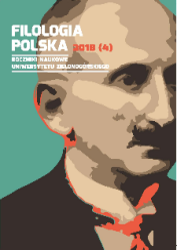A retreat preacher’s “I” in a book entitled Honeycomb [Plaster miodu] by Adam Szustak O.P. [Ordo Praedicatorum]
Keywords
Abstract
The material basis of the sketch is a modified record of Advent retreats named Honeycomb delivered by a popular Dominican preacher Adam Szustak in 2014. The analysis was carried out in two ways. Authors studied linguistic manners of an addresser presence (a retreat preacher’s “I” and “we”) and defined semantic roles of the addresser (a spiritual guide, a Bible expert and interpreter but especially a cinema expert, a member of an order and family communities; furthermore his presence was also noticed thanks to confessions on personal relationships with God). The research allowed answering a question about privacy exposure in addresser’s manifestation – if and how it is present in the text. It has been demonstrated that both confessions on private God’s experiences and details of personal life seem to be a reasonable mean creating bonds with a reader-exercitant and increasing an effectiveness of the preaching.
References
LITERATURA CYTOWANA
Adam Szustak OP laureatem Grand Video Awards, Deon, dostęp: [art,28005,adam-szustak-op-laureatem-grand-video-awards.html].
[Google Scholar]
Bartmiński J., Polifoniczność tekstu czy podmiotu? Podmiot w dialogu z samym sobą, w: Podmiot w języku i kulturze, red. J. Bartmiński, A. Pajdzińska, Lublin 2008.
[Google Scholar]
Bilska M., Wielki Szu, „Tygodnik Powszechny”, dostęp: [wielki-szu-32206].
[Google Scholar]
Gogolik M., Świadectwo nawrócenia w przekazie katechetycznym, „Colloquia Theologica Ottoniana” 2, 2016.
[Google Scholar]
Lalewicz J., Retoryka kategorii osobowych, w: Tekst i zdanie. Zbiór studiów, red. T. Dobrzyńska, E. Janus, Wrocław 1983.
[Google Scholar]
Langusta na palmie, dostęp: [o-mnie], [kalendarz], [o-mnie], [plaster-miodu].
[Google Scholar]
Langusta na palmie, YouTube, dostęp: [watch] [watch].
[Google Scholar]
Okopień-Sławińska A., Semantyczny paradygmat form osobowych, w: Okopień-Sławińska A., Semantyka wypowiedzi poetyckiej (Preliminaria), Kraków 2001.
[Google Scholar]
Pajdzińska A., Sposoby uobecniania się podmiotu w tekście, w: Podmiot w języku i kulturze, red. J. Bartmiński, A. Pajdzińska, Lublin 2008.
[Google Scholar]
Paweł VI, Adhortacja apostolska „Ewangelii nuntiandi”, 1974, p. 41.
[Google Scholar]
Przybylska R., Przyczyna W., Pisownia słownictwa religijnego, Tarnów 2011.
[Google Scholar]
Siwek G., Rekolekcje wczoraj i dziś, Kraków 2011.
[Google Scholar]
Szustak A., Plaster miodu, red. A. Gutowski, Z. Marek, J. Syrek, Kraków 2015.
[Google Scholar]
Wilkoń A., Funkcje kategorii gramatycznych w tekstach literackich: cz. 1: Kategoria osoby, „Język Artystyczny” 1986, nr 4.
[Google Scholar]
Wojtak M., Pragmatyczne aspekty analiz stylistycznych tekstów użytkowych, w: Stylistyka a pragmatyka, red. B. Witosz, Katowice 2001.
[Google Scholar]
M. Wojtak, Współczesne modlitewniki w oczach językoznawcy. Studium genologiczne, Tarnów 2011.
[Google Scholar]
Zdunkiewicz-Jedynak D., Surfując po Internecie w poszukiwaniu Boga… Gatunki komunikacji religijnej na polskich katolickich stronach internetowych, Tarnów 2006.
[Google Scholar]
Zdunkiewicz-Jedynak D., Wykłady ze stylistyki, Warszawa 2013.
[Google Scholar]
Preview
Downloads
Published
How to Cite
Issue
Section
Categories
Copyright & License

This work is licensed under a Creative Commons Attribution-NonCommercial-NoDerivatives 4.0 International License.
Copyrights (a). In principle, authors who are not employed by the University of Zielona Góra retain the copyright, including publishing rights to the articles, without restrictions.
Copyrights (b). In principle, authors who are employed by the University of Zielona Góra, do not retain the copyright, including publishing rights to the articles. In such cases the copyright holder is the University of Zielona Góra.
Print ISSN
2450-3584-
Abstract118











































